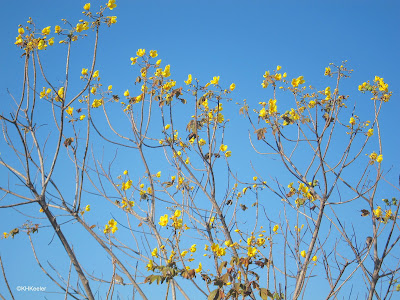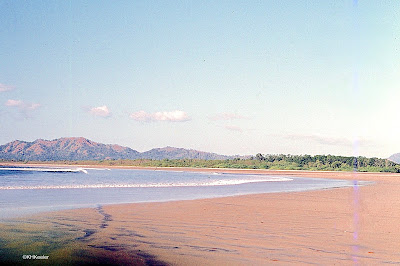February 2021 has put most of North America into a deep freeze, with unfamiliarly cold temperatures and, for many, lots of snow. Flipping through my pictures, I was drawn to memories of Guanacaste Province, Costa Rica...because the memories include being bakingly hot.
 |
| Flowering in January, Cochlospermum vitifolium |
Western Costa Rica has a very seasonal climate, with 70 inches of rain falling between May and October, and virtually none in November to April. At 9 degrees north of the Equator and close to sea level, it is very warm all year. During the rainy season, that warmth is tempered (or intensified, depending on your views) by humidity. During the dry season, the moisture evaporates away, and it is hot (monthly average highs 90-95 February to April) and dry.
Because November to April is winter in the Northern Hemisphere, arriving in Guanacaste from the U.S. during dry season is a radical change. You get on the plane in snow, or the cold rain of winter of the Pacific Coast, and get off to full sunshine, hot temperatures, and just a whiff of humidity. Wow!
So you need to think that it is fiercely hot out when you look at these photos. the sun beating down. You look for shade, to hide from the fierce heat.
 |
| mostly leafless forest, Guanacaste in January |
Shade is elusive. In temperate regions, we talk about deciduous plants as ones that lose their leaves in the fall and are leafless during the winter. But deciduous only means shedding all its leaves annually and Guanacaste is one of the places that needs the broader meaning of deciduous. Many plants drop their leaves and go dormant in the long dry season. Some, especially those growing along streams, do not.
 |
| Many leafless trees on the hillside |
Where the water lingers longer, some plants are evergreen
 |
One of the things ecologists point out about tropical rainforests is a lack of fallen leaves. Despite all the big trees dropping leaves all the time (evergreen, not deciduous), there aren't many leaves on the ground in the rainforest because they decompose rapidly. Guanacaste's tropical dry forest is warm enough for decay in the dry season, but there isn't much moisture, so the leaves lie on the forest floor a while.
 |
| a layer of fallen leaves |
What I find so wonderful about Guanacaste in the dry season--beyond being warm in January-February--are the flowering trees. Many big trees drop their leaves in the dry season then come into flower. The absence of leaves makes the display of flowers much more dramatic, attracting all kinds of pollinators and flower visitors. And the colors of tree canopies range from red and hot pink to yellow and cream to white. Each gorgeous in their own way.
 |
| golden shower tree, Cassia fistulosa not quite leafless |
 |
| white flowers in the leafless canopy, probably Guanacaste tree, Enterolobium cyclocarpum |
 |
| Flowers in the canopy of the buttercup tree, Cochlospermum vitifolium (achiote family, Bixaceae) |
 |
| This is a species of Ruellia (acanthus family, Acanthaceae) a genus of some 335 species, many native to the Americas. |
The Pacific Coast of Guanacaste has long sandy beaches and in the dry season, pretty much nice weather every day. You can fly into the international airport at Liberia and be at the beach in under an hour. My photo is from years ago and today these areas are much more developed (hence the nice airport) but the sand, sky and ocean are still as wonderful.
 |
| Guanacaste beach |
Flowers, heat, green leaves (near the rivers), and big sandy beaches--definitely a place to daydream about during a winter cold snap.
Comments and corrections welcome.
Kathy Keeler, A Wandering Botanist
More at awanderingbotanist.com
Join me on Facebook: https://www.facebook.com/AWanderingBotanist
No comments:
Post a Comment